|
Note: the contents of this article, posted on March 4, 2003, is, except for minor touch-ups, not being updated; it is supposed to stay frozen in time to provide you with a glimpse of how the (hopefully) revolutionary camera was being born. An actual review of the first E-System camera, the E-1, can be found here.
|
|
On March 2, 2003, the Olympus press release hit the fan. It announced a major event in the world of digital cameras — the first interchangeable-lens, digital SLR designed from the ground up as such, not just a modification of a 35-mm SLR body using 35-mm SLR lenses.
The significance of this cannot be overestimated. I may post some general remarks at a later time; now let me share with you the news, including what I could deduct from the published data, including the pictures.
All pictures in this article were provided, and are copyrighted by the manufacturer, and they are posted here in good faith, under assumption of not violating the owner's rights.
Clicking on any of them will reveal a larger version, for a better scrutiny of detail.
|
|
Olympus Press Release
Here is the original Olympus press release, quoted verbatim (with any omissions explicitly marked):
Las Vegas, 02 March 2003, 08:00 a.m.
[...] Between 2 and 5 March, Olympus will unveil, for the first time ever, prototypes of the new Four Thirds system digital SLR camera, lenses and accessories.
The Four Thirds system is a new open standard for digital SLR cameras with interchangeable lenses that utilize a 4/3 inch image sensor. In addition to facilitating the development of camera lens systems specifically designed to maximize digital image sensor performance - without being bound by the design conventions imposed by 35mm film camera SLR systems - the Four Thirds system establishes a common standard for lens mounts, ensuring compatibility between lenses and bodies even if they are produced by different manufacturers. Furthermore, the Four Thirds system interchangeable lenses are much smaller and lighter than 35mm and APS SLR lens systems.
Olympus is currently developing a line-up of Four Thirds system bodies, interchangeable lenses, and accessories that offer professional-quality ruggedness, performance and system expandability.
The interchangeable lenses, developed and manufactured by Olympus, are exceptionally bright and compact, and deliver high quality images that only digital lenses can provide. The new Olympus lenses are (figures in parentheses indicate 35mm film camera equivalent):
- 300 mm, f2.8 (600mm)
- 14-54 mm, f2.8-f3.5 zoom (28-108mm)
- 50 mm, f2.0 macro (100mm)
- 50-200 mm, f2.8-f3.5 zoom (100-400mm)
The camera prototype is sure to impress, with its design tailored to meet the demands of all professional photographers. Its magnesium alloy body provides the protection needed for use in the field and on other rugged assignments, while the power battery holder enables firm and secure holding even when shooting in portrait format. Flash connection is supported via a dedicated hot-shoe. As the professional would expect, manual and automatic adjustment of the aperture, shutter speed and focus is all possible. [...]
Four Thirds system prototypes to be exhibited
- Camera body
- Four lenses
- External flash unit
- Power battery holder
Development background of the new standard
At present, there is no standard in the Digital SLR field. Manufacturers of these camera systems have until now adopted the lens mount used in their own respective 35mm or APS film SLR camera, so bodies and lenses from different manufacturers are incompatible with one another. Also, to use these lenses, manufacturers have increased the size of the image sensor. This means sensors do not reach their full potential.
For example, unlike with film, the light needs to hit the sensor at a high angle of incidence. If not, the periphery of the chip may receive insufficient light, resulting in reduced color definition, particularly when shooting with wide-angle lenses. Furthermore, with such relatively large sensors, bigger and heavier lenses are required to achieve the resolutions required by the micron pitch of the chip's individual sensors.
Benefits
With the Four Thirds system no compromise has been made. It is solely dedicated to the needs of digital image capture and, as an open standard, it also paves the way to cross-manufacturer lens interchangeability. The use of a 4/3-type image sensor size has allowed the dimensions and weight of the lens to be reduced considerably, enhancing handling and mobility. The advantage is particularly clear to see in telephoto lenses. For example, a Four Thirds system 300mm telephoto lens will offer performance equivalent to a 600mm lens on a 35mm film SLR camera. And another benefit: it also impresses with great light gathering power.
|
|
Digging the detail
The press release does not give much detail, but the pictures, obviously showing an advanced prototype, carry quite a lot of it. Let me play a detective, and interpret the pictures, trying to squeeze as much information out of them as humanly possible.
An intimate familiarity with the previous E-10 and E-20 SLRs by Olympus is definitely an advantage here, as the new camera looks very similar to those two. This is good, because both the construction and ergonomics of the older E-10/E-20 models don't leave much to be desired.
It would be quite easy to confuse this body with the E-20. Although almost every detail underwent a subtle change, the general placement of all major controls remains the same.
|
|
Note the changed placement of strap lugs, the new button at the bottom left (depth-of field preview?), and the single / continuous AF switch at bottom right (this suggests a more advanced autofocus system).
The remote control socket has been moved a little towards camera's rear, but both sockets retain the pesky (easy to lose!) screw-in caps. Just to the right of the lens is the lens release button, better seen in the next picture. To the top left is the reference white balance button (unchanged); I just hope the function will work as nicely as in the C-5050Z.
The exact role of the sensor on the grip and another, circular one near the camera top remain unclear.
|
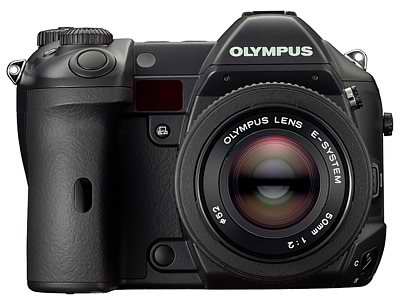
|
|
The location of drive mode and metering pattern controls (at top right) remains unchanged. The macro focus button is missing, which suggests continuous autofocus in the whole distance range. There is a new button for autobracketing, previously activated from the LCD menu. Of other changes, the exposure compensation button has been moved to the top of the camera.
The shutter release is similar to that in the E-10/E-20, but is now protected from accidental release with a taller collar. Also, note the smaller size and lower profile of the front control wheel.
Surprise: no pop-up flash! Although these are not really suitable as the main light source, I find them useful in providing fill-in light outdoors.
|
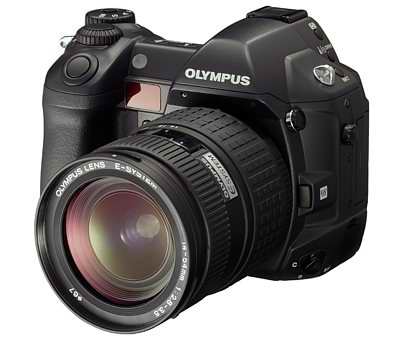
|
|
The top deck has a generously-sized control panel; looks like it may show more information than before. The flash mode, image quality, and white balance buttons remain in old locations, with the panel light button moved slightly to the left. Also, this side is the new home for the exposure compensation control.
The new, external ISO control suggests that Olympus may be more confident in high-gain CCD image quality.
The main dial has only the M, S, A, and P mode positions, but now it uses a central button protecting it from an accidental switch. Image viewing is activated by pressing the green arrow button on the rear side of the camera, and computer connection may kick in when the USB cable is plugged in, like in the newer Olympus cameras.
|
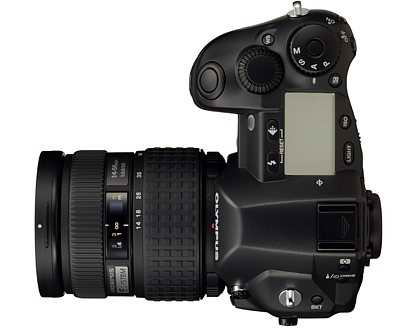
|
|
The controls on the camera's back remain basically unchanged from the E-10/E-20. There is a new [...] button at the far top-right; I suspect it may be for autofocus point selection. There is also a new card compartment lock (there was nothing wrong with the old one). Note the eyepiece shutter and diopter control; the eyepiece itself protrudes out of the body less than before, a good news.
But wait, what happened to the swinging LCD monitor? This one does not look like it is adjustable. On the other hand, in SLRs using mirrors (not semi-transparent prisms), the monitor cannot be used to preview the picture before it is taken, so a tiltable display is not really beneficial.
|
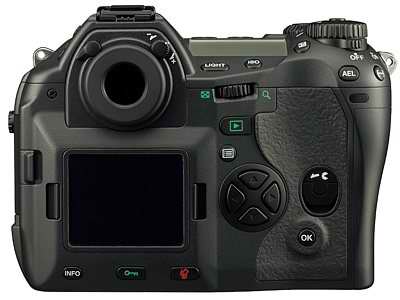
|
|
Note the soft covering at the right thumb grip, where the E-10 and E-20 had just the regular body surface. Small joys of life.
To add my impressions up, looks like Olympus took what was, I believe, the best-handling digital SLR body of the E-10 and E-20, and managed to improve on it with some thoughtful little touches.
If the camera performance matches its ergonomics and (judging from the E-10/E-20 record) build quality, I will have another major investment to make soon.
|
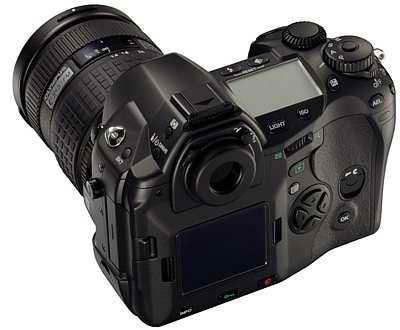
|
|
The lens shown here will be probably bundled with the camera. Its focal length range, 14-54 mm, is equivalent to 28-108 mm on a 35-mm film camera.
The 4/3 sensor size means a four-fold increase in the area as compared to the E-20. If Olympus wanted to use the same pixel density, they could squeeze 20 megapixels into the CCD. This is, of course, highly improbable, but I would consider expectations of 8-11 MP quite reasonable (being more than I actually need). Olympus is tight-lipped about the E-1's pixel count, though.
Back to the lens itself, I believe the focal length range is better than the 35-140mm EFL on previous E-cameras. There is about 2/3 of an F-stop difference in maximum aperture between both ends: F/2.8 versus F/3.5; respectable.
|
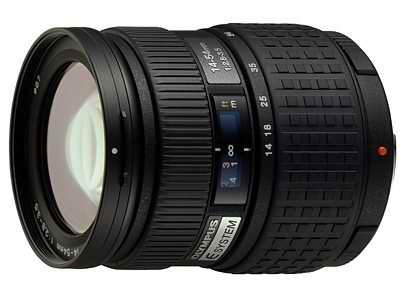
|
|
Note the manual distance scale on all lenses shown here. This may suggest a fully manual focus option (mechanical, as opposed to micro-motor driven), a more precise approach, or at least a better fly-by-wire solution, where the focus ring is more than just a two-way switch.
The lens shown here is a 50 mm (100 mm equiv.) macro, allowing a 1:2 image magnification. If I read the Olympus' claim right, this would be equivalent to the 1:1 ratio on a 35-mm film camera (as the digital image undergoes twice the magnification to be viewed as a print or otherwise). In other words, an object 24 mm tall will fill the frame vertically.
The maximum aperture of F/2.0 is one full F-stop brighter than on similar lenses for film-based SLRs.
|
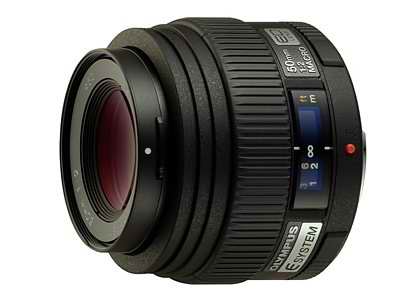
|
|
Now we are getting into some heavy glass. This is a 50-200 mm (100-400 mm equiv.) tele zoom with the maximum aperture of F/2.8, decreasing to F/3.5 at the long end. Hubba hubba. We can see a rotating tripod mount collar, also serving as a carrying handle. (I wonder how much this baby weighs.)
The lens uses some elements of extra-low dispersion glass, but besides this at this time there is no data on the lens construction (groups, elements, special glass), or on the minimum focus distance — for this lens or the other ones.
|
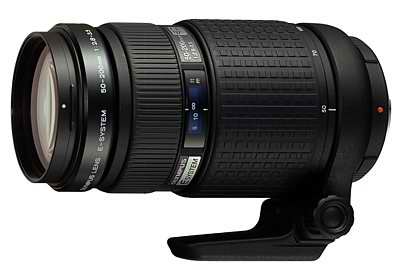
|
|
This is a 300 mm (600 mm equiv.) unit with a maximum aperture of F/2.8, pointed clearly at professional sports and wildlife photographers.
My guess is that the teleconverter shown in the top picture is a 1.5x (or maybe 1.4x) model, judging from the size, and from the fact that this magnification usually offers better image quality at a loss of only one F-stop in effective aperture. When used with this lens, this would mean the equivalent focal length of 900 mm (whoa!) at F/4; now, go and try to match that!
|
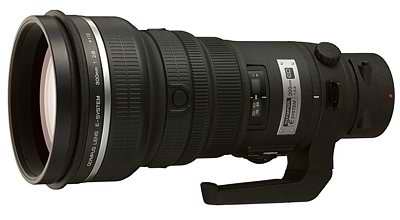
|
|
From other accessories, Olympus announced a power supply (probably lithium-polymer), serving also as a vertical grip, with its own shutter release and a control wheel.
When using an E-10 and E-20, I decided against spending my money on this piece of equipment. This is largely a matter of taste.
|
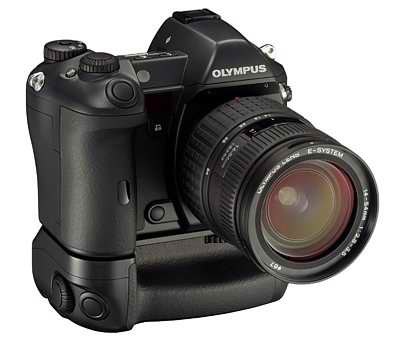
|
|
And, finally, the dedicated flash unit. The guide number and ISO control at the back suggest that this model is supposed to work with other cameras, not just the E-series (this setting is handled by the camera in the dedicated mode). Except for cosmetic differences and for the control panel backlighting this model seems to be similar to the FL-40 from Olympus, although the manufacturer claims it will have enhanced functionality (whatever that means) compared to that model.
I just hope the new camera is compatible with the FL-40 (Olympus says this yet has to be decided upon), as I'm very unwilling to part with another $300 or more for the new unit.
|
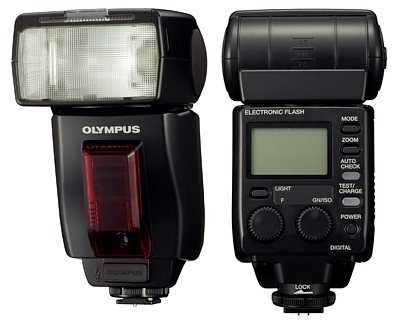
|
|
As you could see, a careful examination of pictures released by Olympus allows for deduction of more technical information than that provided in the official press release.
Of course, we do not know how advanced the prototype is, i.e., how much will the camera evolve before being finally released. I'll be following the developments closely.
More information
From some other pictures and snippets available on the Web we can deduct a few other precious pieces of information.
Power supply: the battery compartment is much smaller and differently shaped that in the E-20; looks like it may hold either a proprietary lithium battery, or two AAs (which I would prefer by much, but would that be enough?).
Sensor type: CCD or CMOS? Olympus keeps quiet on this.
Resolution: Olympus refuses to comment on that, either. As I mentioned above, I wouldn't be surprised with 8-11 MP, but six will be OK with me.
Shutter: Olympus makes no comment on this, but at least one of the PMA articles mentions a focal-plane shutter. Once again, I'm not sure I can believe in this, but this would have both pluses and minuses: a wider range of speeds and easier lens interchangeability on one hand, but the problem of CCD shutter dust pollution on the other.
Viewing system: In one of the interviews an Olympus spokesman said the new camera will have a real swinging mirror (as opposed to a beamsplitter, or another semitransparent reflecting surface). This has some far-reaching implications.
The good news is that a moving mirror results in both a brighter finder, and a higher effective light sensitivity of the camera. This is because a semi-transparent mirror divides the light from the lens into two parts: one reaching the viewfinder, and one — the CCD; therefore both receive less light than they would otherwise.
Now the not-so-good news. A moving mirror is mechanically more complicated and less reliable; the camera is also much noisier. (All these problems have been alleviated in the last fifty years by some very ingenious engineering, but still.)
More importantly, when the optical finder receives the light (with the mirror in the "down" position), the CCD receives none, so the LCD screen cannot be used for viewing. To activate it, Olympus will probably resort to a switch removing the mirror off the way: the optical viewfinder becomes blind, but the electronic one can be used.
|
Olympus® is a registered trademark of Olympus Corporation.
This page is not sponsored or endorsed by Olympus (or anyone else)
and presents solely the views of the author.
|


